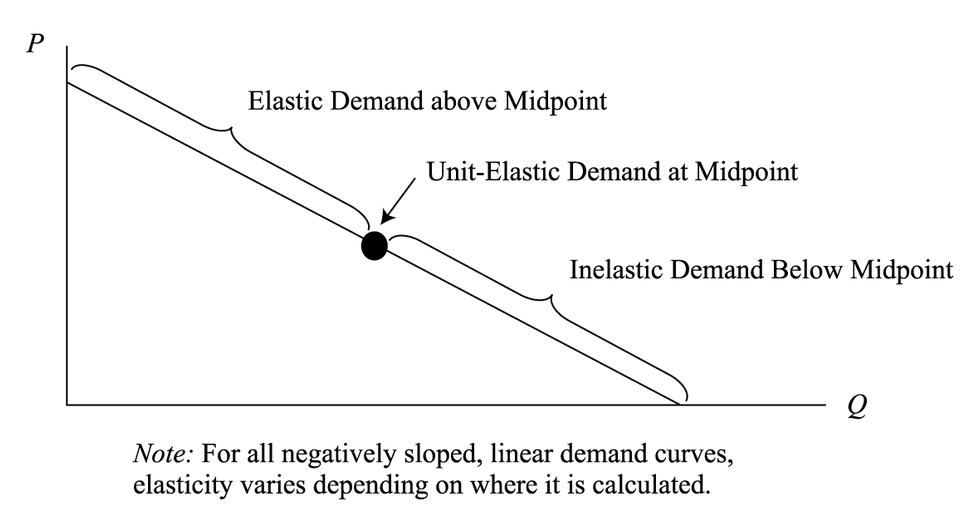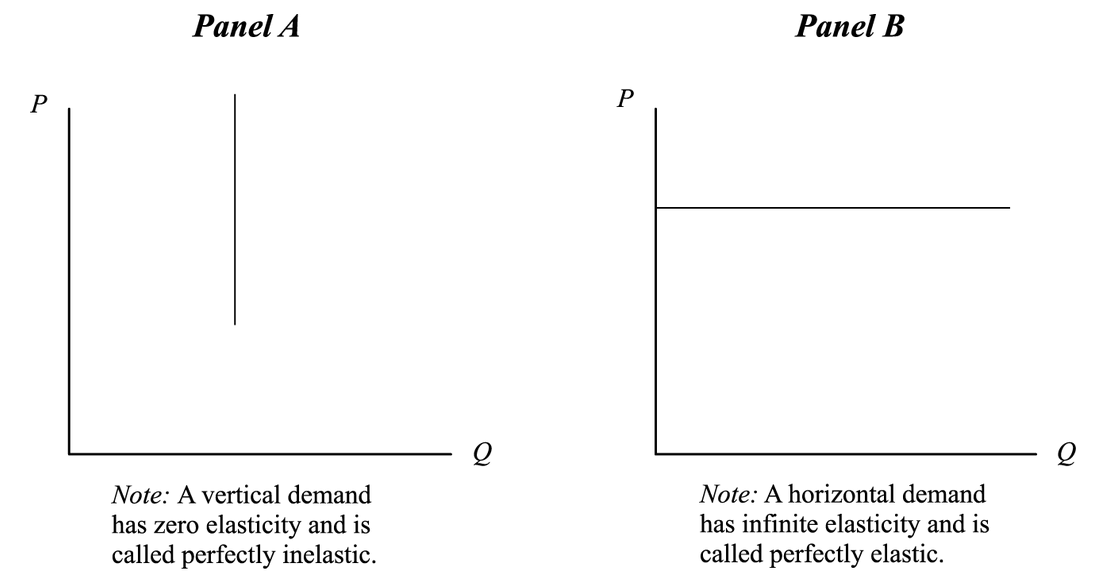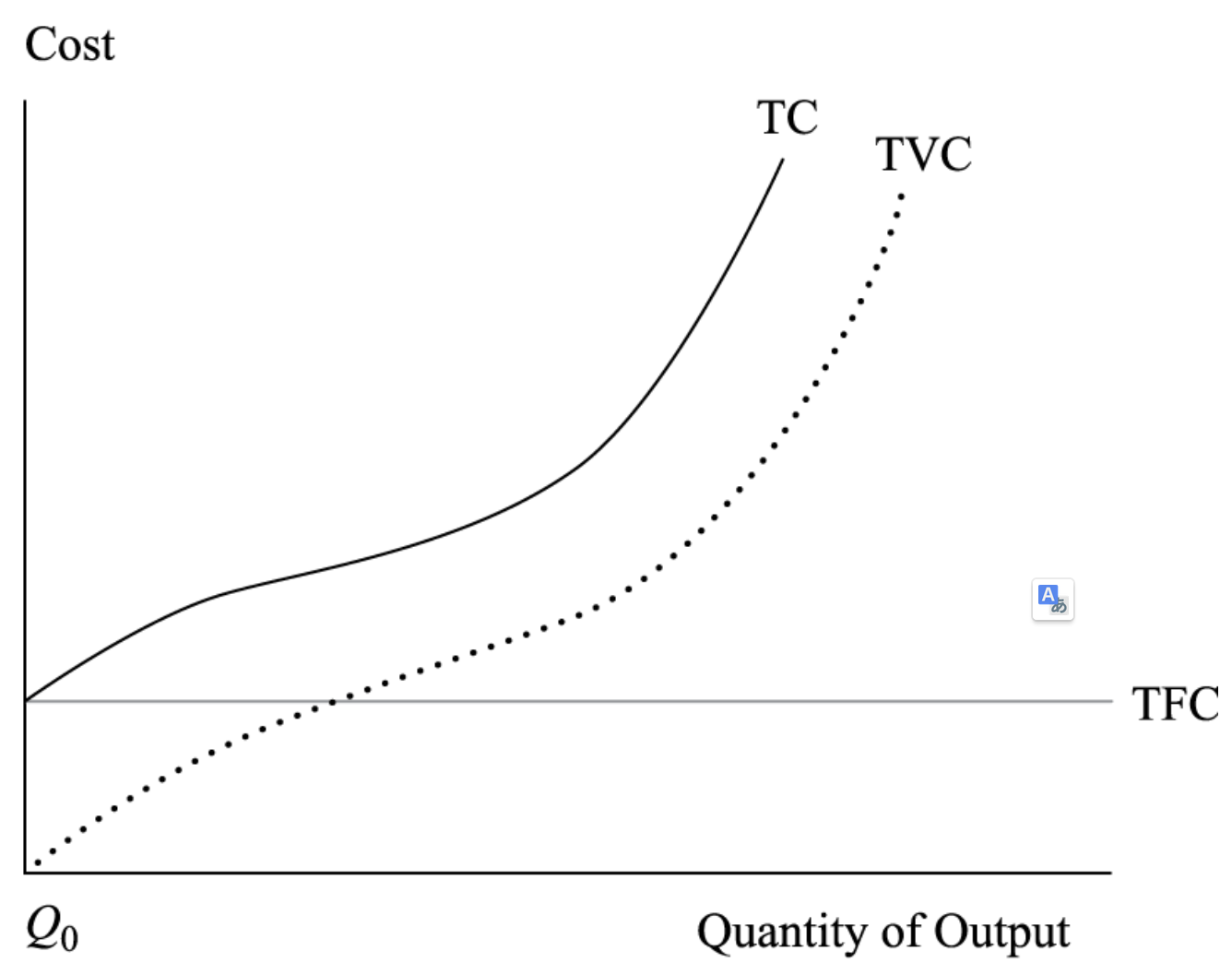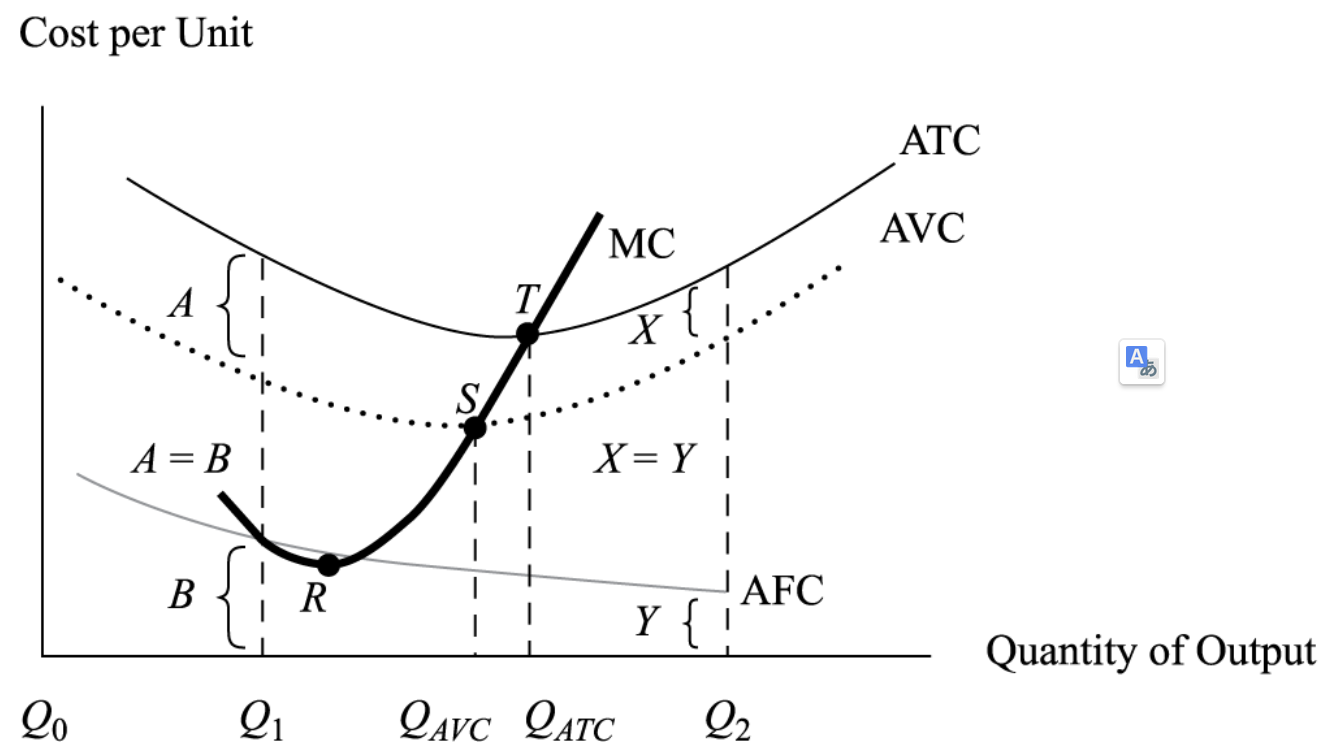law of demand: 价格上升需求减少,反之亦然。
demand function: 例如:$ Q^d_x= f(P_x,I,P_y) $
inverse demand function就是把demand function写成 $ P_x $ 作为因变量的样子,它的graph就是demand curve。
own price: the price of a good or service itself
The law of diminishing returns dictates that additional output must fall as more and more labor is added to a fixed amount of capital.
Economies of scale(规模经济):decreasing long-run cost per unit as output increases。The minimum point on the long-run average total cost curve defines the minimum efficient scale for the firm.
Diminishing marginal returns的对象是Marginal Product而不是Average Product。
Elastic
如果直接用P和Q做对比就会带单位,为了不带单位地表示sensitivity,就要用elasticity。
Own price elasticity
对于线性方程,$ \frac{\Delta Q_x^d}{\Delta P_x^d} $就是demand function中P的系数,计算elasticity只需要再确定一个点就可以算。
intercept:例如对于 $ Q^d_x = 57 − 6.39\times P_x $ ,计算 $ P = 1.48 $ 时的elasticity为-0.2,就是说:当价格是1.48的时候,价格上涨1%会导致需求减少0.2%。
弹性:绝对值小于1时inelastic,大于1时elastic,等于1时unit elastic。

如果demand curve是垂直的1,那么就是perfectly inelastic。如果是水平的,那么就是perfectly elastic2.

粗略推断elastic的考虑因素:
- 可替代性:整个门类比其中的某个厂家的产品更加inelastic
- portion of the typical budget on the good:例如牙膏占budget的比例小,所以即使升价需求的变化也不大;例如房子占budget的比例大,升价会大幅减少需求
- 时间:多数产品在长期比短期更elastic(比如汽油涨价,长期的话可以通过搬家或者增加出行方式来应对,短期就只能继续加油);但是durable goods则相反,短期更有弹性(例如洗衣机降价了很多人就会换,但是长期降价也不会有人买两台)
- 必需性:necessary的产品比optional的更inelastic。
Income Elasticity
Income elasticity可以是正负或者0,也就有了normal goods和inferior goods之分。
通常的demand curve讨论中关注的都是own price跟demand的关系;income是作为常数的一部分来考虑的,因此对于normla goods,income增加等于把曲线往右上移。
Cross-Price Elasticity of Demand
如果另一个商品的价格对需求也有影响,那也可以算elasticity: $E^d_{p_y}=\frac{\%\Delta Q_x^d}{\%\Delta P_y}$ 正的代表另一个商品价格上升这个商品需求增加,所以对方是substitutes。负的则是complements
通常的demand curve讨论中关注的都是own price跟demand的关系;另一个商品的价格也是作为常数的一部分来考虑的,因此对于substitutes,对方价格增加等于把曲线往右上移。
substitution and income effects
Substitution effect:其他商品价格不变的情况下,一个商品降价就会使它相对less costly,从而让消费者买更多。
Income effects:其他商品价格以及收入不变的情况下,一个商品降价的话,就会使得消费者的购买力增加,从而让消费者买得更多。(名义收入不变,实际收入增加)
对于normal goods和inferior goods,substitution effect的效果是相同的(增加购买量);但是income effect对于这两种goods的效果是相反的。(比如对于高收入人群来说快餐就是inferior goods,收入增加就购买快餐更少)
Supply Analysis
Marginal product:the productivity of each unit of input,等于the difference in totoal product from adding another unit of input。(理解英文的表达就行,概念是知道的)
Input productivity:The amount of output produced by workers in a given period of time。
分析的时候关注的input通常只有labor和capital。
- labor指的就是employee time,用labor hours per time period来计量,用L来表示——两个员工每人35小时每周,$ L=70\text{ hours per week } $ 。
- capital则用machine hours per time period来计量,用K表示。
成本等于input乘上input prices:labor的price就是wage rate per labor hour(w),machine的是rental rate per machine hour(r)。所以total cost of production: $TC=(w)(L)+(r)(K)$ 但是这不是cost function,因为cost function表达的关系是cost和output的数量的关系。
更高的productivity的好处包括:
- 更低的business costs,从而有更高的profitability
- 公司的市场价值以及股东财富更高
- 员工得到的奖励更高,motivate labor
Total, Average, and Marginal Product of Labor
这个of后面可以是各种生产所用到的input,但是以labor为例比较直观。将total output以Q表示:
- Total product:Sum of the output from all inputs during a time period
- Average product:Total product divided by the quantity of a given input $ Q/L $
- Marginal product: The amount of additional output resulting from using one more unit of input assuming other inputs are fixed $ \Delta Q / \Delta L $
MR, MC, SMC
MR
Marginal revenue: the additional revenue from selling one more unit,$ \text{MR}=\Delta \text{TR} / \Delta Q $
Total revenue (TR) 有 $ \text{TR}=P\times Q $,那么: $\Delta \text{TR} = P\times \Delta Q + Q\times \Delta P \\ \text{MR}=\frac{P\times \Delta Q}{\Delta Q}+\frac{Q\times \Delta P}{\Delta Q}=P+Q\frac{\Delta P}{\Delta Q}$ 有以下理解:
- $\Delta \text{TR} $的式子说明有两个competing因素影响它:
- 新增的unit($ \Delta Q $)以新的价格卖出
- 因为价格发生了变化($ \Delta P $),现有的unit都得以新的(更低的)价格卖出(而导致的收入减少)
- MR是Price加上一个adjustment
- 由于$ \Delta P / \Delta Q $等于demand curve的斜率,所以:
- 如果是完全竞争市场,demand curve是水平线,斜率是0,此时MR=P
- 如果不是完全竞争市场(比如垄断monopoly),那么$ \text{MR}<P $
MC和SMC
Marginal cost:the increase to total cost from producing one more unit $\text{MC}=\Delta \text{TC}/\Delta Q$ 通常会区分short-run(SMC)和long-run(LMC),区别是短期上只有labor可以变,长期上所有都可以变。
根据 $ TC=(w)(L)+(r)(K) $ 中labor的部分,cost跟w是正相关、跟人均效率是负相关,所以: $\text{SMC}=\frac{w}{\text{MP}_L}$ 对于average variable cost也是有这个关系的 $\text{AVC}=\frac{w}{\text{AP}_L}$
MC和MR
对于以收益最大化(profit-maximizing)为目的的公司,就会追求一个Q同时满足:
- MR=MC
- MC不是负的
TC、TVC、TFC
所谓Fixed cost,也存在不是所有Q都相同的情况,可能是分段fixed。
Normal profit(正常利润)也会被认为是fixed cost,因为投资者要求这个回报,不管Q是多少。

Average和MC(short-run)
Average product of labor (APL) :the total product of labor divided by number of labor hours
Average variable cost (AVC):the ratio of wage to APL

- AFC随着Q增大而降低,因为平摊到更多的unit上了
- MC小于AVC时(S点左侧),AVC下降。(ATC同理)
- R的右侧MC开始上升,意味着capital(以及其他input)限制了labor的发挥
- X小于A因为AFC随着Q增大而降低
对于成本最小化(cost-minimizing)策略的公司来说会选择ATC的最低点的产量;这个点是Profit per unit最大化的,但是不一定是total profit最大化的,所以利润最大化(profit-maximizing)的公司不一定选择这个点。